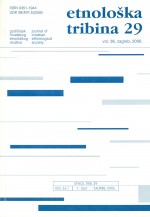Kraljice: između seoskih djevojačkih ophoda i folklorne pozornice
The Kraljice: Between Village Processions for Girls and the Folklore Stage
Author(s): Zorica VitezSubject(s): Theatre, Dance, Performing Arts, Cultural history, Museology & Heritage Studies, Customs / Folklore, Recent History (1900 till today), Cultural Anthropology / Ethnology
Published by: Hrvatsko etnološko društvo
Keywords: customs; Whitsuntide kraljice; folklore festivals; identity;
Summary/Abstract: The article deals with the processions for girls that were held from time to time around Whitsuntide in north-eastern Croatia until the mid-20th century. The participants in those processions were most frequently called kraljice, or queens. After the spontaneous life of that custom, the kraljice moved on to the folklore stage: they have become part of the repertoire of amateur folklore societies and of the professional Lado Folk Song and Dance Ensemble, and they also appear in the folklore festival programmes. This article was written on the basis of research and preparation for presentation of the kraljice at the 39th Zagreb International Folklore Festival in 2005. Summarising the experiences from encounters with the kraljice – both those from the folklore stage and from the former village processions (according to the statements of their participants) – as well as information gleaned from literature about the kraljice, more questions than conclusions impose themselves. It becomes obvious that too little is known about the major differences between the kraljice among the Croats, so that, due to the diversities in the composition of the kraljice processions and the content of their performances, one is lead to ask whether several types of kraljice exist, or whether the differences have arisen because of the changes that have evidently occurred over time and have resulted today in the large number of variants, which differ considerably from each other. Stage life has confirmed the kraljice as an asset that has also established its place in contemporary times, while the presence of the kraljice in the repertoires of culture and art societies contributes to familiarization with and evaluation of local cultural heritage in the particular milieu and outside it. The experience gained in this research suggests the conclusion that the kraljice, as a legacy preserved in the form of stage production, are becoming a symbol of identity.
Journal: Etnološka tribina : Godišnjak Hrvatskog etnološkog društva
- Issue Year: 36/2006
- Issue No: 29
- Page Range: 23-51
- Page Count: 29
- Language: Croatian

